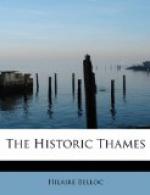The Thames also has entered to a large, though hardly to a determining, extent into the military history of the country; to an extent which is greater in earlier than in later times, because with every new bridge the military obstacle afforded by the stream diminished. And finally, the Thames, regarded as an obstacle, was the cause that London Bridge concentrated upon itself so much of the life of the nation, and that the town which that bridge served, always the largest commercial city, became at last the capital of the island.
We have already said that the establishment of the site of London Bridge was a capital point in the history of the river and the principal line of division in its course. What were the topographical conditions which caused the river to be crossed at this point rather than at another?
It is always of the greatest moment to men to find some crossing for a great river as low down as may be towards the mouth. For the higher the bridge the longer the detour between, at the least, two provinces of the country which the river traverses. It is especially important to find such a crossing as low down as possible when the river is tidal and when it is flanked upon either side by great flooded marshes, as was and is the Thames. For under such conditions it is difficult, especially in primitive times, to cross habitually from one side to the other in boats.
Now it is a universal rule of early topography, and one which can be proved upon twenty of the old trackways of England, that the wild path which the earliest men used, when it approaches a river, seeks out a spur of higher and drier land, and if possible one directly facing another similar spur upon the far side of the water. It is a feature which the present writer continually observed in the exploration of the old British trackway between Winchester and Canterbury; it is similarly observable in the presumably British track between Chester and Manchester; and it is the feature which determined the site of London Bridge.
From the sea for sixty miles is a succession of what was once entirely, and is now still in great part, marshy land; or at least if there are no marshes upon one bank there will be marshes upon the other. In the rare places down stream where there is a fairly rapid rise upon either side of the river the stream is far too wide for bridging; and these marshes were to be found right up the valley until one struck the gravel at Chelsea: even here there were bad marshes on the farther shore.
There is in the whole or the upper stretch of the tidal water but one place where a bluff of high and dry land faces, not indeed land equally dry immediately upon the farther bank, but at least a spur of dry land which approaches fairly near to the main stream. If the modern contour lines be taken and laid out upon a map of London this spur will be found to project from Southwark northward directly towards the river, and immediately opposite it is the dry hill, surrounded upon three sides by river or by marsh, upon which grew up the settlement of London. Here, then, the first crossing of the Thames was certain to be made.




